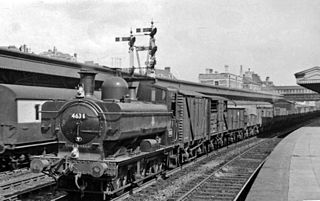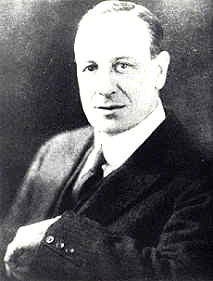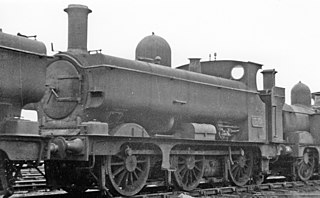
The GWR 5700 Class is a class of 0-6-0 pannier tank steam locomotive built by the Great Western Railway (GWR) and British Railways (BR) between 1929 and 1950. With 863 built, they were the most prolific class of the GWR, and one of the most numerous classes of British steam locomotive.

The Great Western Railway (GWR) 1500 Class is a class of 0-6-0 pannier tank steam locomotive. Despite being a GWR Hawksworth design, all ten were completed under the administration of the Western Region of British Railways in 1949, just after Nationalisation.

The GWR 5600 Class is a class of 0-6-2T steam locomotive built between 1924 and 1928. They were designed by Charles Collett for the Great Western Railway (GWR), and were introduced into traffic in 1924. After the 1923 grouping, Swindon inherited a large and variable collection of locomotives from historic Welsh railway companies, which did not fit into their standardisation programme. GWR boiler inspectors arrived en masse and either condemned the original locomotives or had them rebuilt. The systematic destruction of many examples of locomotives, most still in serviceable condition, followed, but various were worked alongside 5600 Class.

The Great Western Railway (GWR) 5400 Class was a class of 0-6-0 pannier tank steam locomotive. They were similar in appearance to many other GWR tank engines but smaller than the ubiquitous GWR 5700 Class.

Charles Benjamin Collett was Chief Mechanical Engineer of the Great Western Railway from 1922 to 1941. He designed the GWR's 4-6-0 Castle and King Class express passenger locomotives.
The GWR 0-6-0PT, is a type of steam locomotive built by the British Great Western Railway with the water tanks carried on both sides of the boiler, in the manner of panniers. They were used for local, suburban and branch line passenger and goods traffic, for shunting duties, and as banker engines on inclines. The early examples, such as the 1901 and 2021 classes, were rebuilt from saddle or side tanks when the locos received a Belpaire firebox – this type of firebox has a square top and is incompatible with a curved saddle tank. This process mostly took place during the tenure at Swindon Works of George Jackson Churchward. Only a very small number of saddle tank locomotives escaped rebuilding as panniers, notably the 1361 Class built new under Churchward in 1910, by which date a few of the 1813 Class had already been rebuilt as pannier tanks.

The GWR 1901 Class was a class of 120 small 0-6-0ST steam locomotives. Numbered 1901–2020, they were designed by George Armstrong and built at the Wolverhampton railway works, England, of the Great Western Railway between 1881 and 1895. They had wheels of 4 ft 0 in (1.219 m) diameter and a coupled wheelbase of 13 ft 8 in (4.17 m).

The GWR 2021 Class was a class of 140 0-6-0ST steam locomotives. They were built at the Wolverhampton railway works of the Great Western Railway between 1897 and 1905. 1897 was the very year of George Armstrong's retirement, so it is uncertain if the design should be attributed to him or to his superior at Swindon, William Dean.

The GWR 645 Class was a class of 0-6-0ST designed by George Armstrong and built at the Wolverhampton railway works of the Great Western Railway (GWR). Thirty-six were constructed between 1872-3, of which three were built for the South Wales Mineral Railway (SWMR), two for the Carmarthen and Cardigan Railway (C&CR) and the remainder for the GWR. In essence, they were saddle tank versions of his GWR 633 Class of 1871. From 1878, a further 72 of the class, partially enlarged, were added in the 1501 numbering sequence. Unlike the originals, the "1501"s had full-length saddle tanks from the start.

The North Eastern Railway (NER) Class Y 4-6-2T tank locomotives were designed whilst Wilson Worsdell was Chief Mechanical Engineer, but none were built until 1910 by which time Vincent Raven had taken over.
The GWR 2721 Class was a class of 0-6-0ST steam locomotives. They were designed by William Dean and built at the Swindon Works of the Great Western Railway between 1897 and 1901.
The Daniel Gooch standard gauge locomotives comprise several classes of locomotives designed by Daniel Gooch, Superintendent of Locomotive Engines for the Great Western Railway (GWR) from 1837 to 1864.
Between 1854 when the Shrewsbury and Chester and Shrewsbury and Birmingham Railways were absorbed by the Great Western Railway, and 1864 when he moved south to Swindon Works, Joseph Armstrong occupied the post of the GWR's Locomotive Superintendent, Northern Division, at Wolverhampton Works. For ten years the task of providing new locomotives for the GWR's newly acquired standard gauge lines fell jointly to Armstrong and to his superior Daniel Gooch, the railway's principal Locomotive Superintendent who was based at Paddington.
The GWR 633 Class were 0-6-0Ts designed by George Armstrong and built at the Wolverhampton railway works of the Great Western Railway between November 1871 and April 1872. These were always Southern Division locomotives, but over the years some were fitted to work the Metropolitan lines and played a large role in the transportation of goods from Acton to Smithfield. Unusually, they had side tanks, and inside frames, with wheels of 4 ft 6+1⁄2 in (1,384 mm) in diameter and a wheelbase of 15 ft 6 in (4.72 m). Their weight was 34 long tons 12 cwt. There were twelve locomotives, numbered 633–644.

Class 655 of the Great Western Railway was a class of 52 0-6-0ST locomotives designed by George Armstrong and built at the GWR's Wolverhampton Works.
The 1016 Class consisted of sixty double framed 0-6-0ST locomotives designed by George Armstrong and built at the Wolverhampton Works of the Great Western Railway between 1867 and 1871. Like the earlier 302 Class of Joseph Armstrong, the 1016s had 4 ft 6 in (1.372 m) wheels and a 15 ft 6 in (4.72 m) wheelbase, dimensions that would remain traditional for the larger GWR pannier tanks right through to Charles Collett's 5700 Class, and with little change to Frederick Hawksworth's 9400 Class of 1947.
The 119 Class of the Great Western Railway consisted of a series of 11 0-6-0ST locomotives. They were numbered 119-21 and 123-30 and had originally been built in 1861 at Swindon Works as tender engines to a design of Daniel Gooch, part of the 79 Class. Their rebirth as tank engines was the result of their being renewed at Wolverhampton railway works under the aegis of George Armstrong between 1878 and 1883.
The Great Western Railway's 1813 Class was a series of 40 0-6-0T built at Swindon Works in two lots of 20 engines each. No. 1813 was sold to the Pembroke & Tenby Railway in May 1883 becoming No.7 Holmwood, retaining this name after being absorbed by the GWR. Nearly all of these engines spent their lives on the GWR's Southern Division.
The 1661 Class was William Dean's second design of tank locomotive for England's Great Western Railway. Like the 1813 Class which preceded them, there were 40 1661s, turned out of Swindon Works in two batches.
The GWR 1854 Class was a class of 0-6-0T steam locomotives designed by William Dean and constructed at the Swindon Works of the Great Western Railway. The class used similar inside frames and chassis dimensions to the 1813 Class of 1882-4. In this they differed from the intervening 1661 Class, which had reverted to the double frames of the Armstrong era. Thus the 1854 Class belongs to the "mainstream" of GWR 0-6-0T classes that leads towards the larger GWR pannier tanks of the 20th century.










